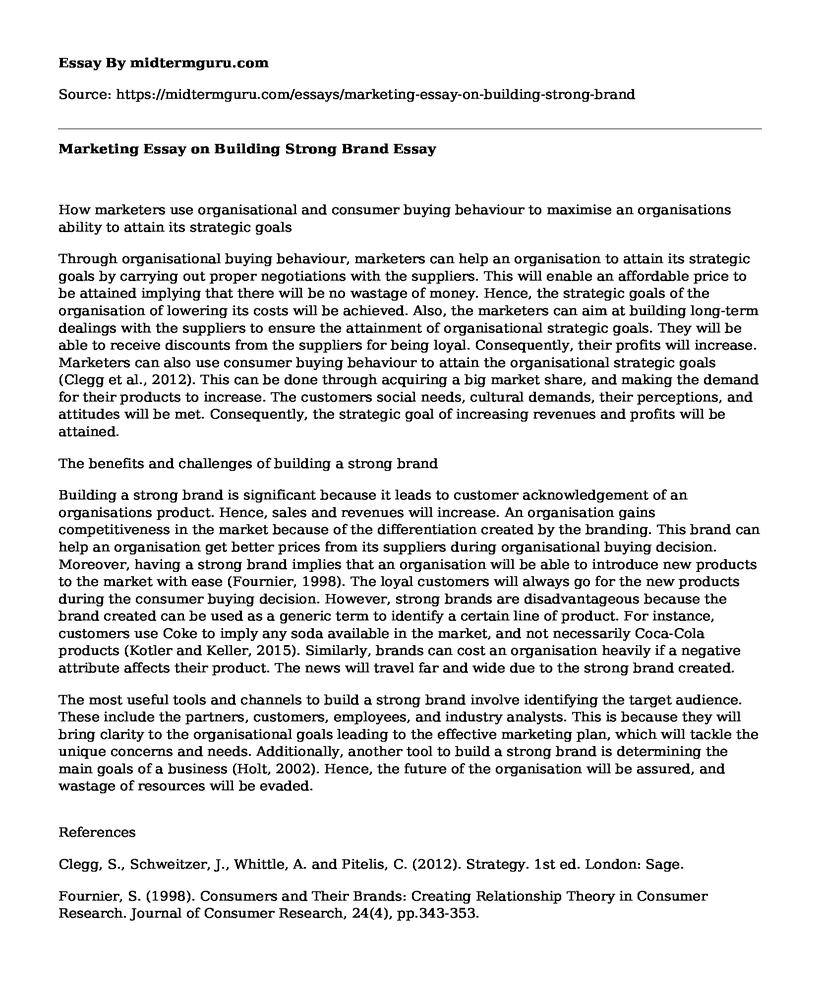How marketers use organisational and consumer buying behaviour to maximise an organisations ability to attain its strategic goals
Through organisational buying behaviour, marketers can help an organisation to attain its strategic goals by carrying out proper negotiations with the suppliers. This will enable an affordable price to be attained implying that there will be no wastage of money. Hence, the strategic goals of the organisation of lowering its costs will be achieved. Also, the marketers can aim at building long-term dealings with the suppliers to ensure the attainment of organisational strategic goals. They will be able to receive discounts from the suppliers for being loyal. Consequently, their profits will increase. Marketers can also use consumer buying behaviour to attain the organisational strategic goals (Clegg et al., 2012). This can be done through acquiring a big market share, and making the demand for their products to increase. The customers social needs, cultural demands, their perceptions, and attitudes will be met. Consequently, the strategic goal of increasing revenues and profits will be attained.
The benefits and challenges of building a strong brand
Building a strong brand is significant because it leads to customer acknowledgement of an organisations product. Hence, sales and revenues will increase. An organisation gains competitiveness in the market because of the differentiation created by the branding. This brand can help an organisation get better prices from its suppliers during organisational buying decision. Moreover, having a strong brand implies that an organisation will be able to introduce new products to the market with ease (Fournier, 1998). The loyal customers will always go for the new products during the consumer buying decision. However, strong brands are disadvantageous because the brand created can be used as a generic term to identify a certain line of product. For instance, customers use Coke to imply any soda available in the market, and not necessarily Coca-Cola products (Kotler and Keller, 2015). Similarly, brands can cost an organisation heavily if a negative attribute affects their product. The news will travel far and wide due to the strong brand created.
The most useful tools and channels to build a strong brand involve identifying the target audience. These include the partners, customers, employees, and industry analysts. This is because they will bring clarity to the organisational goals leading to the effective marketing plan, which will tackle the unique concerns and needs. Additionally, another tool to build a strong brand is determining the main goals of a business (Holt, 2002). Hence, the future of the organisation will be assured, and wastage of resources will be evaded.
References
Clegg, S., Schweitzer, J., Whittle, A. and Pitelis, C. (2012). Strategy. 1st ed. London: Sage.
Fournier, S. (1998). Consumers and Their Brands: Creating Relationship Theory in Consumer Research. Journal of Consumer Research, 24(4), pp.343-353.
Holt, D. (2002). Why Do Brands Cause Trouble? A Dialectical Theory of Consumer Culture and Branding. Journal of Consumer Research, 29(1), pp.70-90.
Kotler, P. and Keller, K. (2015). A framework for marketing management. 1st ed. Harlow: Pearson Education.
Cite this page
Marketing Essay on Building Strong Brand. (2021, Jun 24). Retrieved from https://midtermguru.com/essays/marketing-essay-on-building-strong-brand
If you are the original author of this essay and no longer wish to have it published on the midtermguru.com website, please click below to request its removal:
- Paper Example on How Approaches Affect Online Consumer Behavior
- Online Grocery Shopping Industry Analysis Paper Example
- Research Paper on Effects Of 3D Printing Technology on Logistics Within the Supply Chain
- Essay Sample on Supply Chain Logistic Drivers
- New Product Launch: Strategic Persuasion to Create Positive Brand Impact - Essay Sample
- Periodic Changes in Purchases & Supplies Impact Professionalism - Essay Sample
- Essay Sample on Facebook and Advertisement







